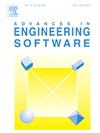基于离散元法的煤壁参数标定及高精度模型构建研究
IF 5.7
2区 工程技术
Q2 COMPUTER SCIENCE, INTERDISCIPLINARY APPLICATIONS
引用次数: 0
摘要
在虚拟样机仿真中,离散单元煤壁模型的准确性对煤岩破碎机理表征和设备动态响应具有重要影响。以兖州煤矿鄂尔多斯文玉矿煤岩样品为研究对象,通过Plackett-Burman试验和最陡爬坡试验,确定了影响颗粒抗压强度的Tavares UFRJ关键参数。采用最优拉丁超立方体抽样(OLHS)和高斯过程回归(GPR)对断裂参数进行了标定。然后通过单轴压缩模拟校准带有键合参数的Hertz-Mindlin。通过离散元法-多柔体动力学(DEM-MFBD)耦合仿真验证了模型的准确性。结果表明,D0、E∞和Phi是最显著的参数,其影响率分别为38.5%、30.5%和18.6%。模拟颗粒抗压强度与实验颗粒抗压强度的相对误差小于4.56%,单轴压缩模拟颗粒抗压强度的最大相对误差小于9.80%。对比采煤机滚筒切削过程的三轴载荷曲线,实验值与仿真值的最大平均值相对误差为3.72%,均方根误差(RMSE)最大为4.60%,优于传统模型,验证了该模型用于动态切削过程仿真的准确性和可靠性。本文章由计算机程序翻译,如有差异,请以英文原文为准。
Research on coal wall parameter calibration and high precision model construction based on discrete element method
The accuracy of discrete element coal wall model significantly influences the characterization of coal-rock breaking mechanisms and equipment dynamic response in virtual prototype simulation. Based on coal-rock samples from Ordos Wenyu Mine of Yanzhou Coal Mining, key Tavares UFRJ parameters affecting particle compressive strength were identified through Plackett-Burman test and steepest ascent experiment. Breakage parameters were calibrated using optimal latin hypercube sampling (OLHS) and gaussian process regression (GPR). Hertz-Mindlin with Bonding parameters were then calibrated via uniaxial compression simulation. Model accuracy was verified through discrete element method-multi flexible body dynamics (DEM-MFBD) coupling simulation. Results indicate that D0, E Infinity, and Phi are the most significant parameters with influence rates of 38.5 %, 30.5 %, and 18.6 % respectively. The relative error between simulated and experimental particle compressive strength is below 4.56 %, while uniaxial compression simulation shows maximum relative error below 9.80 %. Comparing tri-axial load curves during shearer drum cutting, the maximum relative error of mean values between experimental and simulation data is 3.72 %, with maximum root mean square error (RMSE) of 4.60 %, outperforming traditional models and validating the model's accuracy and reliability for dynamic cutting process simulation.
求助全文
通过发布文献求助,成功后即可免费获取论文全文。
去求助
来源期刊

Advances in Engineering Software
工程技术-计算机:跨学科应用
CiteScore
7.70
自引率
4.20%
发文量
169
审稿时长
37 days
期刊介绍:
The objective of this journal is to communicate recent and projected advances in computer-based engineering techniques. The fields covered include mechanical, aerospace, civil and environmental engineering, with an emphasis on research and development leading to practical problem-solving.
The scope of the journal includes:
• Innovative computational strategies and numerical algorithms for large-scale engineering problems
• Analysis and simulation techniques and systems
• Model and mesh generation
• Control of the accuracy, stability and efficiency of computational process
• Exploitation of new computing environments (eg distributed hetergeneous and collaborative computing)
• Advanced visualization techniques, virtual environments and prototyping
• Applications of AI, knowledge-based systems, computational intelligence, including fuzzy logic, neural networks and evolutionary computations
• Application of object-oriented technology to engineering problems
• Intelligent human computer interfaces
• Design automation, multidisciplinary design and optimization
• CAD, CAE and integrated process and product development systems
• Quality and reliability.
 求助内容:
求助内容: 应助结果提醒方式:
应助结果提醒方式:


